Léon Van Dievoet
Léon Van Dievoet (/ˈdiːvʊt/; 5 July 1907–6 December 1993) was a Belgian architect[1], painter, engraver, and draughtsman.[2]
Léon van Dievoet | |
|---|---|
| Born | 5 July 1907 |
| Died | 6 December 1993 |
| Nationality | Belgium |
| Occupation | architect, painter, engraver, and drawer. |
| Parent(s) |
|
| Family | Van Dievoet family |
He is the author of numerous drawings of places in Brussels that have since been demolished[1] which have been described as a "mine of information for all those interested in the Brussels of yesteryear".[3]
Selected works
- Drawings
- Rue de la Porte Rouge, Bruegel House, 1939
- Saint-Josse Church, July 1942
- Saint-Job Church in Uccle, June 1943
- Dead end in the rue de la Chapelle, 1939
- Chapel Church, April 1941
- Paintings
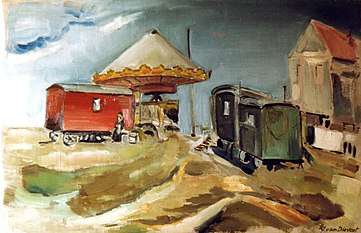 Le Carrousel, August 1939
Le Carrousel, August 1939- Ferme à Beersel, 1979
- Architecture
_par_architecte_LEON_VAN_DIEVOET_1957.jpg) House of artist Lismonde, chaussée de Ninove, 1957
House of artist Lismonde, chaussée de Ninove, 1957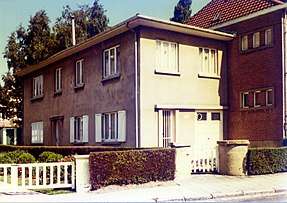 Durdut house, rue Langeveld, Uccle
Durdut house, rue Langeveld, Uccle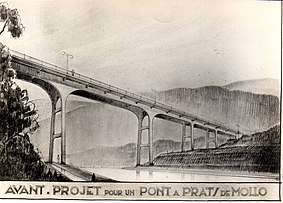 Project for a bridge in Prats de Mollo, 1935
Project for a bridge in Prats de Mollo, 1935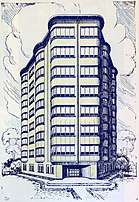 Project for a building, quartier des Nations, 1936
Project for a building, quartier des Nations, 1936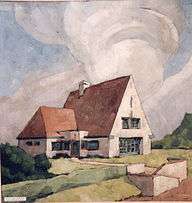 Project for a villa, 1936
Project for a villa, 1936
Honours


Notes and references
- "La famille van Dievoet, l'art et l'architecture". puzzlavie.be (in French). Retrieved 2020-05-26.
- "Léon van Dievoet". photos-promenade.be (in French). Retrieved 2020-05-26.
- In French: "mine d'informations pour tous ceux qui s'intéressent au Bruxelles d'antan". F. By, "Famille van Dievoet : Artistes, de père en fils", in Le Vif/L'Express numéro spécial Bruxelles: la saga des grandes familles, vol. 26, no. 47 (Le Vif) and no. 2993 (L'Express), 21–27 November 2008, p. 121.
Further reading
- 1930-1931 : Annuaire général des beaux-arts de Belgique, Brussels, 1930-31, p. 192 : « Projet d'hôtel ».
- 1933 : Jean Groffier, « Un interview. L'architecte Léon Van Dievoet », in : La momie chante. Arts, Sciences, Lettres, Bruxelles, juillet 1933, p. 2.
- 2003 : Dictionnaire de l'Architecture en Belgique de 1830 à nos jours, direction : Anne Van Loo, Antwerp : Fonds Mercator, 2003, p. 562.
- 2003 : Paul Piron, « VAN DIEVOET, Léon », in Dictionnaire des artistes plasticiens de Belgique des XIXe et XXe siècles, Ohain-Lasne, 2003, volume L-Z, p. 619.
gollark: Inasmuch as converting analog input from a microphone into different frequencies through some analog process actually counts as encoding, I guess.
gollark: You have to have *some* encoding step to translate your data into radio signals.
gollark: Or possibly some other SDRs.
gollark: I vaguely remember reading about RTL-SDRs being used to reverse-engineer (partly) LoRa and some satellite phone encoding.
gollark: If they were using some bizarre exotic encoding but not actually encrypting it it would still be *possible*, if *very hard*, to decode it without the actual docs.
This article is issued from Wikipedia. The text is licensed under Creative Commons - Attribution - Sharealike. Additional terms may apply for the media files.